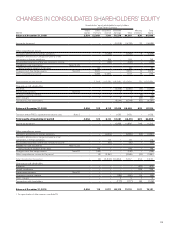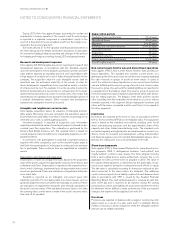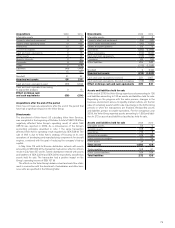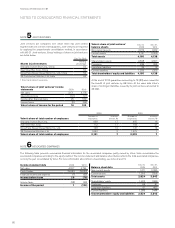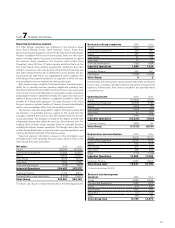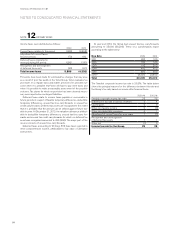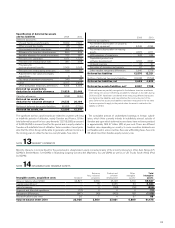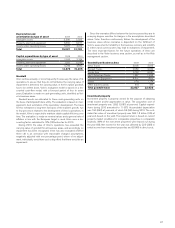Volvo 2010 Annual Report Download - page 81
Download and view the complete annual report
Please find page 81 of the 2010 Volvo annual report below. You can navigate through the pages in the report by either clicking on the pages listed below, or by using the keyword search tool below to find specific information within the annual report.
in the valuation allowance may be needed that could materially impact
the financial position and the income for the period. At December 31,
2010, the valuation allowance amounted to 339 (296) for the value of
deferred tax assets. Net of this valuation allowance, deferred tax
assets of 20,109 (21,533 ) were recognized in the Group’s balance
sheet.
Volvo has significant tax-loss carryforwards which are related to
countries with long or indefinite periods of utilization, mainly Sweden
and France. Of the total deferred tax asset for loss carryforwards
7,327 (8,939), an amount of 3,665 (4,653) relates to Sweden with
indefinite time of utilization. Volvo considers it to be most certain that
the Volvo Group will be able to generate sufficient income in the com-
ing years to utilize the tax-loss carryforwards.
Inventory obsolescence
Inventories are reported at the lower of cost, in accordance with the
first-in, first-out method (FIFO), and net realizable value. The esti-
mated net realizable value includes management consideration of
outdated articles, over-stocking, physical damages, inventory lead-
time, handling and other selling costs. If the estimated net realizable
value is lower than cost, a valuation allowance is established for inven-
tory obsolescence. The total inventory value, net of inventory obsoles-
cence allowance, is per December 31, 2010, 39,837 (37,727).
Credit loss reserves
The establishment of credit loss reserves on customer financing
receivables is dependent on estimates including assumptions regarding
past dues, repossession rates and the recovery rate on the underlying
collaterals. At December 31, 2010, the total credit loss reserves in the
segment Customer Finance segment amounted to 1.69% (1.67) of
the total credit portfolio in the segment. See note 36 for a description
of the credit risk.
Pensions and other post-employment benefits
Provisions and costs for post-employment benefits, mainly pensions
and health-care benefits, are dependent on assumptions used by
actuaries in calculating such amounts. The appropriate assumptions
and actuarial calculations are made separately for the respective
countries of Volvo’s operations which result in obligations for post-
employment benefits. The assumptions include discount rates, health
care cost trends rates, inflation, salary growth, long-term return on
plan assets, retirement rates, mortality rates and other factors. Volvo’s
assumptions regarding discount rate are presented in note 24. Health
care cost trend assumptions are based on historical cost data, the
near-term outlook, and an assessment of likely long-term trends. Infla-
tion assumptions are based on an evaluation of external market indi-
cators. The salary growth assumptions reflect the long-term actual
experience, the near-term outlook and assumed inflation. Retirement
and mortality rates are based primarily on officially available mortality
statistics. The actuarial assumptions are reviewed on an annual basis
and modifications are made to them when it is deemed appropriate to
do so. Actual results that differ from management’s assumptions are
accumulated and amortized over future periods. See Note 24 for more
information regarding costs and assumptions for post-employment
benefits. At December 31, 2010 net provisions for post-employment
benefits amounted to 5,862 (6,002).
Product warranty costs
Estimated costs for product warranties are charged to cost of sales
when the products are sold. Estimated warranty costs include con-
tractual warranty and goodwill warranty (warranty cover in excess of
contractual warranty or campaigns which is accepted as a matter of
policy or normal practice in order to maintain a good business relation
with the customer). Warranty provisions are estimated with consideration
of historical claims statistics, the warranty period, the average time-lag
between faults occurring and claims to the company and anticipated
changes in quality indexes. Differences between actual warranty
claims and the estimated claims generally affect the recognized
expense and provisions in future periods. Refunds from sup pliers, that
decrease Volvo’s warranty costs, are recognized to the extent these
are considered to be certain. At December 31, 2010 warranty cost
provisions amounted to 7,841 (7,947).
Legal proceedings
Volvo recognizes obligations in the Group accounts as provisions or
other liabilities only in cases where Volvo has a present obligation
from a past event, where a financial responsibility is probable and
Volvo can make a reliable estimate of the size of the amount. In
instances where these criteria are not met, a contingent liability may
be disclosed in the notes to the accounts.
Volvo regularly reviews the development of significant outstanding
legal disputes in which Group companies are parties, both civil law
and tax disputes, in order to assess the need for provisions and con-
tingent liabilities in the financial statements. Among the factors that
Volvo considers in making decisions on provisions and contingent
liabilities are the nature of the dispute, the amount claimed, the
progress of the case, the opinions or views of legal counsels and other
advisers, experience in similar cases, and any decision of Volvo’s man-
agement as to how Volvo intends to handle the dispute. The actual
outcome of a legal dispute may deviate from the expected outcome of
the dispute. The difference between actual and expected outcome of
a dispute might materially affect future financial statements, with an
adverse impact upon the Group’s results of operation, financial pos-
ition and liquidity. See note 29 for the Volvo Group’s gross exposure to
contingent liabilities.
NOTE 3 CHANGE OF ACCOUNTING PRINCIPLES
New accounting principles in 2010
The following new accounting principles are effective from January 1,
2010 and have been applied by the Volvo Group unless stated other-
wise:
Revised IFRS 3 Business combinations
The standard became effective on July 1, 2009 and applies to fiscal
years beginning on or after that date. The standard entails changes to
the reporting of future acquisitions regarding for example the account-
ing of transaction costs, any contingent considerations and step
acquisitions. The Group applies the amendment as of January 1,
2010. The application affects the accounting for business combin-
ations made from the application date. Capitalized transaction costs
of 135 relating to ongoing acquisition projects is transferred to equity
by Volvo.
77




